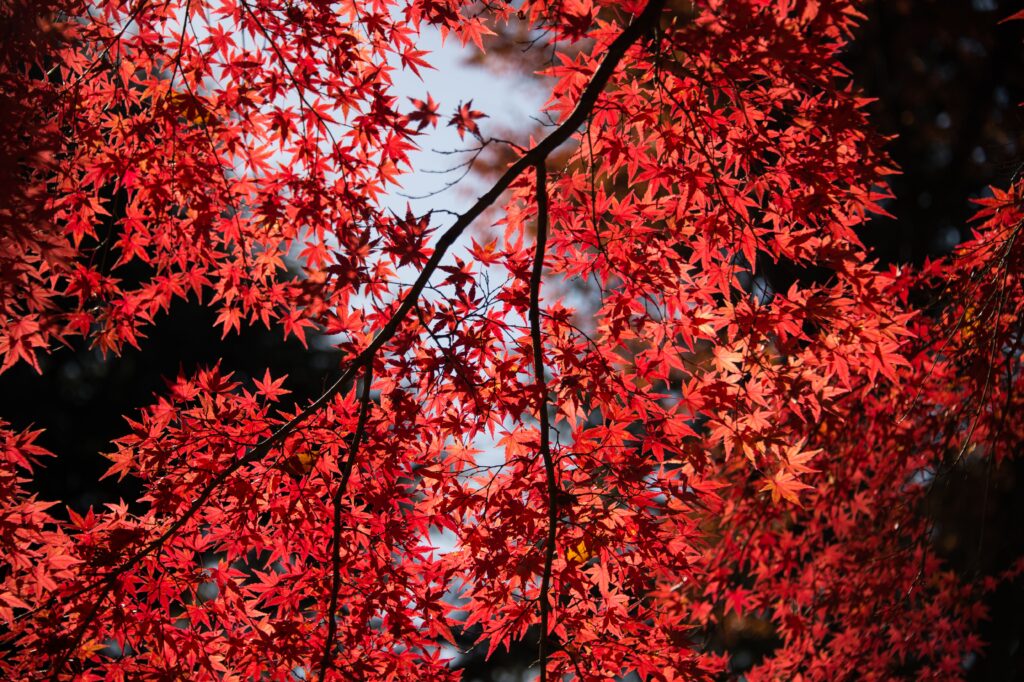Red maple trees (Acer rubrum) are deciduous trees native to eastern North America and Canada. They are well-known for their eye-catching red foliage, which appears in the fall and adds a splash of color to the landscape. Red maple tree leaves are typically three to six inches long and shaped like a star or five-pointed leaf. Small red flowers bloom on the tree in the spring, followed by small red fruit in the summer.
Why Plant Red Maple Tree?
Red maple trees are well-known for their adaptability and versatility, as they can thrive in a wide range of soil types and climates. They can survive in both dry and wet conditions and can withstand temperatures as low as -30°F. Red maple trees can also thrive in urban areas and can withstand air pollution.
Red maple trees are considered fast-growing and can reach heights of up to 100 feet and widths of up to 50 feet. Because of their round canopy and dense network of branches, they are a popular choice for shading large areas.
The beautiful red foliage that appears in the fall is one of the most appealing features of red maple trees. Depending on the variety of red maple trees and the growing conditions, the color of the leaves can range from a bright scarlet to a deep burgundy. Red maple trees have a distinctive red bark that enhances to their ornamental appeal in addition to their colorful leaves.
Benefits of Planting Maple Tree?

Because of their attractive appearance and numerous benefits, maple trees, also known as Acer spp., are a popular choice for landscaping. Here are some of the most compelling reasons to plant a maple tree in your yard:
- Colorful foliage: One of the most appealing characteristics of maple trees is their colorful foliage, which can range from yellow to orange to red. These vibrant colors are a lovely and eye-catching addition to any landscape.
- Shade: Because maple trees have a dense canopy of branches, they are an excellent choice for providing shade in your yard. They can be grown to provide shade for your house, patio, or other outdoor areas.
- Maple trees are known for their adaptability and can thrive in a wide range of soil types and climates. As a result, they are suitable for a wide range of landscapes.
- Maple trees provide food and shelter to a variety of birds and animals, making them an excellent choice for wildlife gardens. Samaras, or “helicopters,” are maple tree seeds that are popular among birds and small mammals.
- Erosion control: Because maple trees have deep root systems that help to anchor the soil, they are an excellent choice for planting on slopes or in erodible areas.
- Maple trees have a high ornamental value and can add visual interest to any landscape. They come in a variety of shapes, sizes, and colors, making it simple to find one that meets your specific requirements.
Maple trees require little maintenance and are simple to care for. They do not require regular pruning and can thrive with little care.
How to plant a Red Maple tree?

Because of their attractive red foliage and adaptability to a wide range of soil types and climates, red maple trees are a popular choice for landscaping. Here are the steps to take if you want to plant a red maple tree in your yard:
- Select the best location: Red maple trees grow best in full sun to partial shade and in well-drained soil. Planting them in areas prone to standing water or with heavy clay soil is not recommended.
- Prepare the soil as follows: Before planting your red maple tree, use a garden fork to loosen the soil and remove any weeds or debris. To improve drainage, if the soil is heavy clay or compacted, mix in compost or other organic matter.
- Dig the hole: The hole for your red maple tree should be twice as wide and twice as deep as the root ball. If your soil is poor, you may need to build a raised bed by mounding soil in the center of the hole.
- Plant the tree as follows: Place the tree in the hole after carefully removing it from its container or burlap wrapping. Fill in the hole with soil, ensuring that the tree is planted at the same depth it was in its original container. Tamp the soil down to remove any air pockets.
- Water and mulch: Thoroughly water the tree to help the soil settle and eliminate any air pockets. To help retain moisture and suppress weeds, add a layer of mulch around the base of the tree.
- Red maple trees do not require frequent pruning, but any damaged or crossing branches should be removed. This can be done while the tree is dormant in the winter or early spring.
You can successfully plant a red maple tree and enjoy its attractive red foliage and adaptability for years to come if you follow these steps.
Conclusion
Because of their adaptability and ability to thrive in a variety of conditions, red maple trees are a popular choice for landscaping. They are also an excellent choice for wildlife gardens because they provide food and shelter to a wide range of birds and animals.
Overall, red maple trees are a lovely and adaptable addition to any landscape, and their red foliage adds a pop of color to the autumn season.